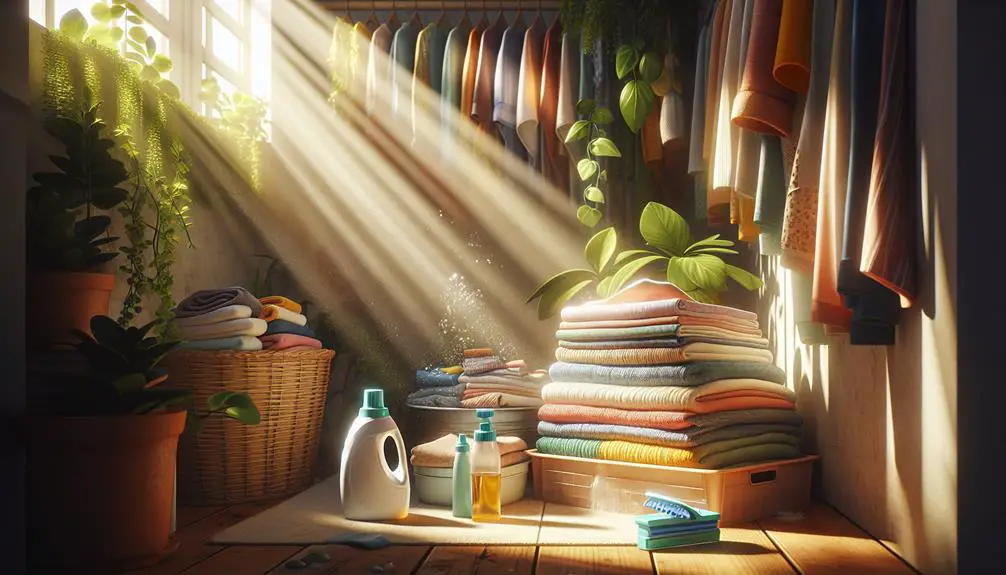Imagine your favorite shirt lasting twice as long with just a few simple adjustments to your routine. You don't need to be an expert to prolong the lifespan of your fabrics—just start by washing in cold water and avoiding high heat settings. Eco-friendly detergents and air drying can make a significant difference. Have you ever wondered how fabric storage affects longevity or how to handle stubborn stains promptly? By paying attention to these details, you'll find that maintaining the vibrancy and integrity of your clothing becomes second nature. Let's explore these essential techniques further.
Table of Contents
Key Takeaways
- Use cold or lukewarm water for washing to preserve color and elasticity.
- Choose eco-friendly, phosphate-free detergents to avoid weakening fabric integrity.
- Air dry clothes to prevent shrinkage and preserve fabric quality.
- Follow care labels for proper heat settings when ironing or drying.
- Store seasonal fabrics in breathable containers with moisture absorbers.
Proper Washing Techniques
Understanding proper washing techniques can greatly extend the lifespan of your fabrics. First, consider the water temperature you use. Hot water can cause shrinking and fading, especially in delicate fabrics. Instead, choose cold or lukewarm water. This not only preserves the color and elasticity but also reduces the risk of fabric damage.
Next, let's discuss fabric softeners. While they can make your clothes feel soft and smell fresh, they may also leave residues that weaken fibers over time. As a substitute, try using white vinegar. Adding a half-cup of vinegar to the rinse cycle can soften fabrics without the harmful buildup, and it's also a natural deodorizer.
Moreover, avoid overloading your washing machine. Overcrowded loads lead to increased friction, which can result in pilling and wear. Give your fabrics enough space to move freely for an ideal clean.
Lastly, always separate your laundry by color and fabric type. Washing heavy items like jeans with lightweight fabrics can cause unnecessary wear and tear. By following these washing techniques, you'll maintain the integrity and appearance of your fabrics for years to come.
Choosing the Right Detergents
Choosing the right detergent is essential for maintaining your fabrics.
You'll want to avoid harsh ingredients,
consider eco-friendly options,
and understand the different types available.
Let's explore how each factor can help keep your clothes looking their best.
Ingredients to Avoid
When selecting a detergent, avoid those with harsh substances like bleach or phosphates. These harmful chemicals can jeopardize fabric safety, resulting in weakened fibers and faded colors. You want your clothes to last, so it's essential to steer clear of harmful additives that can deteriorate the fabric.
Here's a quick list of ingredients to avoid for best fabric preservation:
- Bleach: While bleach is effective at whitening, it's highly caustic and can harm fabric fibers over time.
- Phosphates: Frequently found in many detergents, phosphates can leave residues that weaken the fabric's integrity.
- Optical Brighteners: These substances enhance the brightness of clothes but can make fabric brittle and more susceptible to tearing.
- Synthetic Fragrances: These often contain alcohol and other harsh substances that can degrade fabric and irritate your skin.
Eco-Friendly Options
After steering clear of harmful ingredients, you can confidently explore eco-friendly detergent options that are gentle on both your fabrics and the environment. Choosing the right detergent is essential for maintaining sustainable fashion practices. You'll find that green cleaning strategies not only prolong the lifespan of your garments but also contribute to a healthier planet.
Look for detergents labeled as biodegradable, phosphate-free, and plant-based. These formulations minimize water pollution, ensuring that your laundry routine aligns with eco-friendly principles. Concentrated detergents are another prudent choice—they reduce packaging waste and often require less water for rinsing, making them a dual win for sustainability.
When evaluating products, pay attention to certifications from reputable organizations like the Environmental Working Group (EWG) or USDA Organic. These endorsements provide assurance that the detergent meets stringent environmental and health standards. Opt for brands that use minimal plastic in their packaging or offer refillable options to further reduce your ecological footprint.
Detergent Types Explained
Understanding the different types of detergents can help you make informed choices that best suit your fabric care needs. Choosing the right detergent isn't just about cleaning power—it's about fabric preservation and extending the life of your favorite clothes.
Let's delve into the options available and how each can serve your laundry tricks.
- Liquid Detergents: Ideal for pre-treating stains and dissolving rapidly, liquid detergents work well in both cold and hot water. They're perfect for everyday laundry and managing tough stains on delicate fabrics.
- Powder Detergents: These are great for general loads and heavily soiled items. They're effective at removing ground-in dirt and clay but mightn't dissolve completely in cold water, potentially leaving residue.
- Pods/Capsules: Convenient and pre-measured, pods guarantee you use the correct amount of detergent every time. They're excellent for consistent results but might be more costly per load.
- High-Efficiency (HE) Detergents: Specifically designed for HE washers, these detergents produce fewer suds and rinse out more effectively. They're essential for maintaining your washer's performance and ensuring prime fabric care.
Your detergent selection directly impacts the longevity of your clothes. Choose wisely to keep your fabrics looking their best.
Drying Methods and Tips
When drying your fabrics, consider air drying to reduce wear and tear.
If you use a machine, be mindful of the heat settings to avoid damage.
Always check the care labels to make sure you're using the proper drying method.
Air Drying Benefits
Air drying your clothes can significantly extend their lifespan by reducing wear and tear from machine drying. While there are numerous benefits to air drying, it's important to understand both the advantages and potential drawbacks.
Benefits:
- Cost-Efficiency: You save on electricity and lower your energy bills.
- Fabric Integrity: Air drying preserves the structural integrity of the fibers, preventing shrinkage and stretching.
- Eco-Friendly: It's a more environmentally friendly option, reducing your carbon footprint.
- Freshness: Outdoor drying can give your clothes a natural, fresh scent.
However, there are some drawbacks to take into account. For example, outdoor drying can be weather-dependent, and indoor drying may take longer and require space.
When choosing between indoor and outdoor drying, take your environment into consideration. Outdoor drying is ideal when you have good weather and space for a clothesline. Indoor drying is beneficial for delicate fabrics and during inclement weather but make sure you have enough ventilation to prevent mold and mildew.
Here are some tips to maximize air drying benefits:
- Shake Out Clothes: This helps reduce wrinkles and speeds up drying.
- Use Hangers: Hang shirts and dresses to preserve their shape.
- Avoid Direct Sunlight: For bright colors to prevent fading.
- Use a Drying Rack: For smaller items or delicate fabrics.
Mastering these techniques will guarantee that your fabrics last longer and remain in excellent condition.
Machine Drying Precautions
To protect your fabrics endure machine drying without damage, follow these essential precautions and tips. First, always check the care labels on your garments. Ignoring these can lead to shrinking or stretching, compromising the longevity of your fabrics.
Separate your laundry by fabric type and weight; this simple step guarantees that lighter, delicate items aren't subjected to the same intensity as heavier fabrics.
When it comes to fabric softeners, consider alternatives like wool dryer balls or white vinegar. Traditional softeners can leave residue that builds up over time, dulling the fabric's appearance and reducing its lifespan. Wool dryer balls, on the other hand, help reduce drying time and static without harmful chemicals.
To prevent shrinking, avoid overloading the dryer. Overcrowding limits airflow, causing uneven drying and increasing the risk of damage. Shake out your clothes before placing them in the dryer to minimize wrinkles and promote even drying. Consider using mesh laundry bags for delicate items to provide extra protection against agitation.
Proper Heat Settings
Understanding the proper heat settings is key to preventing damage and preserving the quality of your fabrics during drying. By mastering temperature control, you guarantee fabric protection and extend the lifespan of your garments. Here are essential tips to get you started:
- Read Labels Carefully: Always check the care labels on your clothes. They provide specific instructions on the best heat settings for each fabric type, making sure you avoid unnecessary heat exposure.
- Use Low Heat for Delicates: For delicate fabrics like silk, lace, and synthetics, always opt for the lowest heat setting. This minimizes heat exposure and maximizes fabric longevity.
- Medium Heat for Everyday Wear: Cotton blends, linens, and other everyday fabrics generally do well on a moderate heat setting. This balance provides enough warmth to dry the material without causing undue wear.
- High Heat for Heavy Loads: Reserve high heat settings for heavy-duty fabrics like towels and jeans. These materials can withstand higher temperatures and require more heat to dry completely.
Mastering the art of temperature control not only enhances fabric protection but also guarantees your favorite pieces remain in top condition. By integrating these tips into your routine, you'll effectively prolong the lifespan of your fabrics.
Safe Ironing Practices
Before you get started, always check the care label on your fabric to set the iron to the right temperature. Different fabric types require different ironing temperatures to prevent damage. For instance, cotton can withstand higher heat, whereas delicate fabrics like silk need a much cooler setting. By adhering to these guidelines, you'll ensure your fabrics maintain their integrity and appearance.
To begin, fill your iron with distilled water to avoid mineral residues. Set the iron according to the fabric type specified on the care label. For mixed fabrics, always choose the lower temperature to avoid scorching. Use a pressing cloth for added protection, especially for delicate materials. This simple barrier can prevent direct heat contact and reduce the risk of burns or shine marks.
Iron in smooth, consistent motions, avoiding prolonged contact with any single area. Start with the less visible parts of the garment, like the inside hem, to test the temperature. If you notice any resistance or sticking, lower the heat immediately.
Storing Seasonal Fabrics
Properly storing your seasonal fabrics guarantees they remain in excellent condition year after year. To achieve this, consider the following expert strategies:
- Vacuum Sealing:
This technique is superb for off-season storage. By eliminating air, you minimize the risk of mold, mildew, and pests. Plus, vacuum sealing saves space and keeps your fabrics looking pristine.
- Use Breathable Containers:
While plastic bins might seem convenient, they can trap moisture. Opt for breathable fabric bags or cotton storage bins to encourage airflow and ensure moisture prevention, which is crucial for fabric preservation.
- Add Moisture Absorbers:
To further safeguard your fabrics, place silica gel packets or cedar balls in your storage containers. They're excellent for keeping the environment dry, thereby preventing any moisture-related damage.
- Store in a Cool, Dry Place:
Temperature and humidity can wreak havoc on fabric. Avoid basements and attics where conditions fluctuate. Instead, choose a closet or room with stable conditions to maintain your fabrics' integrity.
Handling Stains Effectively
When you encounter a stain, acting promptly and knowing the right techniques can make all the difference in preserving your fabrics. Start with spot treatment: blot, don't rub, to avoid pushing the stain deeper into the fibers. Use a clean cloth and work from the outside in to prevent spreading.
Prevention tips are equally vital; treat your fabrics with a protective spray to repel liquids and dirt.
DIY remedies can be highly effective. For organic stains like coffee or wine, a mixture of baking soda and water creates a gentle paste that lifts the stain. For greasy stains, a few drops of dish soap can work wonders. Always test any DIY remedy on an inconspicuous area first to make sure it won't damage the fabric.
However, not all stains are created equal. Sometimes, professional help is necessary to save your cherished fabrics. Stubborn stains or delicate materials may require specialized cleaning techniques only professionals can provide. Knowing when to seek expert assistance can prevent irreversible damage and prolong the lifespan of your fabrics.
Mastering these techniques guarantees your fabrics remain pristine and long-lasting, reflecting your dedication to excellence in fabric care.
Regular Maintenance Routine
Consistent care through a regular maintenance routine guarantees your fabrics stay in top condition and last longer. By incorporating a few key habits into your routine, you can make sure your fabrics remain vibrant and durable.
First, proper fabric storage is essential. Always store your fabrics in a cool, dry place to prevent mold and mildew. Avoid direct sunlight, which can fade colors and weaken fibers over time.
Second, practice immediate stain removal. Address stains as soon as they occur to prevent them from setting in. Use a gentle cleaner appropriate for your fabric type and test it on a small, inconspicuous area first.
Third, follow these steps for a thorough maintenance routine:
- Regular Cleaning: Wash or dry clean your fabrics according to their care labels. This prevents dirt and oils from accumulating and degrading the material.
- Inspect for Damage: Regularly check for signs of wear and tear. Address small issues like loose threads or minor tears before they become larger problems.
- Proper Folding: Fold your fabrics neatly to avoid unnecessary creases and stress on the fibers.
- Rotation: Rotate items in use frequently to make sure even wear and extend their overall lifespan.
Special Care for Delicate Fabrics
Delicate fabrics like silk, lace, and chiffon require extra attention to maintain their beauty and integrity. To keep these fabrics looking their best, handling them with care and using appropriate cleaning techniques is crucial.
First, consider professional dry cleaning for items that are particularly delicate or valuable. Dry cleaning uses solvents instead of water, which can prevent fabric shrinkage and color bleeding. However, selecting a reputable service is vital to ensure your garments receive the best care.
At home, fabric steaming is a gentle method to remove wrinkles without causing damage. Steamers don't make direct contact, reducing the risk of tearing or stretching. Always test a small area first to make sure the fabric responds well to steam.
Here's a quick guide to help you care for delicate fabrics:
| Fabric Type | Special Care Tips |
|---|---|
| Silk | Use fabric steaming and avoid direct sunlight. |
| Lace | Hand wash with mild detergent, lay flat to dry. |
| Chiffon | Steam on a low setting, avoid high heat. |
| Cashmere | Gentle washing, dry flat, avoid wringing. |
| Velvet | Steam inside out, avoid pressure marks. |
Frequently Asked Questions
How Can Fabric Softeners Impact the Lifespan of My Fabrics?
Fabric softener effects can make your clothes feel like clouds, but they can also weaken fibers over time. For expert fabric care tips, try using natural alternatives to keep your fabrics strong and long-lasting.
Are There Eco-Friendly Methods to Prolong Fabric Longevity?
You can extend fabric longevity using natural detergents and sustainable storage. Repair techniques help maintain integrity, while upcycling projects breathe new life into old items. These eco-friendly methods guarantee your fabrics last longer and stay vibrant.
Does Fabric Type Affect How Frequently It Should Be Replaced?
Imagine owning a delicate silk blouse; its fabric durability and maintenance demand careful handling. Fabric type indeed affects replacement frequency. For instance, durable denim jeans last longer with proper care, unlike frequently replaced, less durable cotton tees.
Can Sunlight Exposure Damage Fabrics Over Time?
Yes, sunlight exposure can damage fabrics over time. You should use sunlight protection to prevent UV damage. This helps in avoiding fabric fading and guarantees color preservation, maintaining the fabric's quality and appearance for longer.
What Are the Best Practices for Reducing Fabric Pilling?
Have you mastered fabric care yet? Prevent pilling by using gentle washing techniques and avoiding high heat during drying. Regular fabric maintenance, like using a fabric shaver, keeps your clothes looking fresh and smooth.
- How Does Ring Spun Cotton Affect Garment Fit and Shape Retention? - August 13, 2024
- What Are the Challenges in Producing Ring Spun Cotton? - August 13, 2024
- Is Ring Spun Cotton Suitable for Plus-Size Clothing? - August 13, 2024






